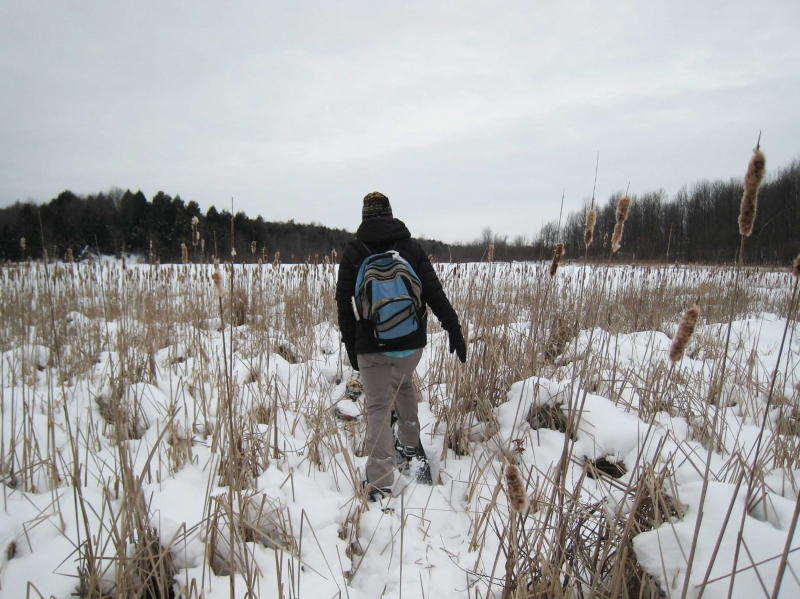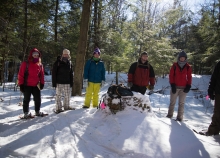
An Old Rusty Trap
This winter Nature Up North is featuring a Winter Ecology Series, in which St. Lawrence University students in Dr. Karl McKnight's Winter Ecology course share their observations from a weekly field trip to Glenmeal State Forest in Pierrepont. We hope you enjoy their accounts from days spent in the woods examining the fascinating ways plants and animals endure the North Country winter.
By James Chandler
13 February 2014
Snowshoeing through cattails can be tricky business. It is tedious work traversing the highly variable terrain, unsure if your foot will break through the thin ice crust, even before your shoes get caught on cattail stalks and shrubs buried below the surface. Inevitably this will happen and will trip you up, and you will likely stumble into a fuzzy seedpod land mine hovering at the end of the cattail stalk. If you’re lucky you will escape with only a few unwanted seeds clinging to your clothes, but sometimes the pods explode into a cloud hopeful travellers looking to catch a lift to a new home. The risk of getting covered in seeds is rewarded by the possibility of finding an abandoned bird’s nest tucked up in the dense branches of the underbrush. The masterful and intricate waving of branches, twigs, grass, fur, and other fuzzy detritus is a fantastic show of the painstaking work put into each nest by their builders. It is amazing that birds make the effort year after year to create these works of art.

I am continually impressed at the new things I see when walking through the woods. I have always been fascinated at the forest’s ability to tell a visual story of its history, and if you spend enough time and look closely enough the tale becomes clear. This week I saw something I have never seen before in the woods. Walking through the woods on the fringes of a beaver pond, we were following the track of a fisher cat. I strayed off course a hair to examine something in the snow and as I did so looked up to see a peculiar object suspended from a small hemlock tree. Unsure of what it was I ventured up to check it out. Much to my surprise it was an old, rusty foot trap that had been left, hanging at chest height from the trunk of the tree. Its weathered hinges squeaked as they reluctantly shifted their position but the spring was still strong even after years of abandonment. Judging by the tree growth engulfing the chain attached to the trap it was clear by that the trap had not been touched for a long time. A relic from the past, the trap made me thing about who might have been walking these woods before us and what they were looking for.
I thought about how their purpose for being out there would have been drastically different from ours. We were exploring to learn, they were probably out there to survive, hunting and trapping as a means of getting food and an income. A lifestyle so drastically different from my own that I have a hard time putting myself in the shoes of such a person at that time. I can only imagine how tough it would have been to survive the long cold winters in the North Country trying to subsist on preserved food from the summer season and what ever one could track down in the winter months. I love how small things like finding a trap in the woods can make you think about the past, how they tell a piece of a story and how one can try to put that story together.
Comments
Good day!! I really love the
Good day!! I really love the snow out there it keeps me remind of somethin wonderful like the movie frozen dude. im OLAF haha. Anyways check this out to, <a href="http://socialsoundcloud.org/buy-soundcloud-followers/" rel="nofollow">buy soundcloud followers</a>


I'm very glad and happy to see peoples who still find ways to conserve mother nature,There are a lots of changes in our climate due to the our abusive acts to nature, but we can still prevent calamity if we are going to stop those people who destroy the nature.
<a href="http://socialexperience.org/buy-twitter-favorites/" rel="nofollow">buy twitter favorites</a>